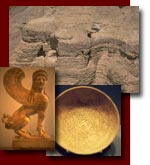| Site Map | Contacts | Links | Newsletter | |
Biblical Archaeology:
Seminar Report
On May 10, 2001 Dr. Kyle McCarter, Jr. spoke about the beginning of the first alphabet.
The Acrophonic Principle: One would draw a picture of an object that started with the sound of the letter one wanted to use. For example, one would draw the picture of a hand to stand for the "k" sound.
An important discovery of the earliest alphabetical inscriptions was made in Egypt in the wadi el Hole(?) by John Darnell that date to around 1800 BC.
McCarter posits that the alphabet was invented by Asiatics living in Egypt (or the Sinai) about 2000 BC under Egyptian influence to be practical in understanding and writing hieroglyphics. One no longer needed to learn thousands of signs of hieroglyphics or cuneiform.
The alphabet spread from Egypt to the Sinai, to Israel on up to Syria.
The alphabet was then spread by the maritime Phoenicians across the Mediterranean Sea where the Greeks adopted it as well as the Romans with some changes.
So who really invented the alphabet? See http://www.iht.com/articles/51582.htm
The Winged-Sun Disk of Hezekiah
In lecture two McCarter explained the meaning and background for the winged-sun disk that was used as a royal seal for Hezekiah. The seal is a picture of a scarab beetle (the creator god) pushing the sun across the sky.
Some scholars see this as an identification of Yahweh as a solar deity. Why would Hezekiah use this Egyptian symbol?
The king before Hezekiah, Ahaz used no winged scarab. Ahaz had sided with Assyria while Samaria sided with Egypt. The result was that Israel was taken captive by the Assyrians. When Hezekiah became king there was a change in policy. Sargon is killed and Sennacherib comes to power. Hezekiah joins the revolt against Assyria. Hezekiah sides with Egypt.
Hezekiah then uses Egyptian symbols like the solar scarab. Hezekiah prepares for revolt by making many jars with his royal seal of the winged scarab for rations for the army. Wall were fortified. A tunnel was cut out for water to flow into Jerusalem.
The Assyrian army comes and all surrender except the Philistines and Hezekiah. Jerusalem is besieged. Tribute is paid and Sennacherib leaves. There are several versions of this story. See The Sun's Shadow Moved Back.
